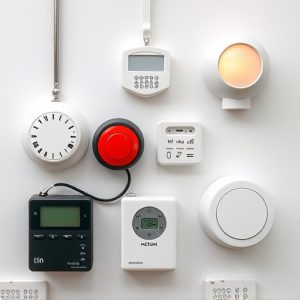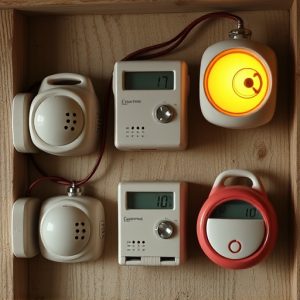Personal Alarm Sound: Effective Wall Penetration for Enhanced Safety
Mobile panic button alarm systems enhance personal safety with powerful yet discreet capabilities. E…….
Mobile panic button alarm systems enhance personal safety with powerful yet discreet capabilities. Emitting high-decibel Personal Alarm Sounds that penetrate walls, these devices alert neighbors and emergency services instantly. Customizable signals, automatic triggers, and connection to monitoring services ensure swift response for solo living, mobility challenges, or remote areas. Advanced features like GPS tracking and fall detection provide comprehensive safety, making them indispensable for outdoor activities and personal security. Effective wall penetration through concrete, brick, and modern insulated structures ensures immediate assistance in distress scenarios.
“Discover the life-saving potential of mobile panic button alarm systems, a revolutionary tool for personal safety. This comprehensive guide explores the core components, from ‘Understanding Mobile Panic Button Alarm Systems’ to their surprising ability to ‘Penetrate Walls Effectively’. Learn about key features, benefits of the ‘Personal Alarm Sound’, and real-world applications that highlight these devices’ versatility. By delving into different types of wall construction and their impact on alarm penetration, we ensure a thorough understanding of this vital safety technology.”
- Understanding Mobile Panic Button Alarm Systems
- Key Features and Benefits of Personal Alarm Sound
- How Mobile Alarms Penetrate Walls Effectively
- Types of Wall Construction and Alarm Penetration
- Real-World Applications and User Stories
Understanding Mobile Panic Button Alarm Systems
Mobile panic button alarm systems are designed to provide personal safety by offering a discrete and effective means of summoning help in emergency situations. These compact devices typically incorporate a loud, attention-grabbing personal alarm sound capable of penetrating walls to alert neighbors, emergency services, or anyone nearby. The user can activate the alarm with a simple press of a button, instantly signaling distress and location information.
This technology is particularly useful for individuals who live alone, have mobility issues, or frequent areas where help may be delayed. Advanced systems even allow users to customize alert signals, set automatic activation triggers, and connect to monitoring services for rapid response. With their compact size and robust alarm sounds, these mobile panic buttons offer a sense of security and peace of mind, ensuring that help is on the way when needed most.
Key Features and Benefits of Personal Alarm Sound
Personal Alarm Sounds are designed to be high-decibel, attention-grabbing signals that can break through noise and even penetration walls in emergency situations. This key feature ensures that help is summoned swiftly, critical for personal safety especially when alone or in remote areas. The sound is typically loud, sharp, and distinct, varying from piercing whistles to blaring sirens, allowing users to choose the most effective option for their needs.
Benefits extend beyond the immediate auditory impact; these alarms often come with additional features like automatic fall detection, GPS tracking, and emergency contact options. Some models even integrate with existing home security systems, providing a comprehensive safety net. The Personal Alarm Sound’s ability to pierce through walls is a game-changer in situations where yelling or calling for help might be ineffective, making it an indispensable tool for outdoor activities, travel, and personal security.
How Mobile Alarms Penetrate Walls Effectively
Mobile panic button alarm systems have revolutionized personal safety by offering a discreet yet powerful tool for emergencies. The effectiveness of these devices lies in their ability to penetrate walls, ensuring that help can be summoned swiftly from any location. When activated, the high-decibel personal alarm sound projects through specialized technology, allowing it to bypass structural barriers and reach neighboring spaces or nearby emergency services quickly.
This penetration capability is achieved through advanced acoustic waves that can travel through solid surfaces, making them ideal for homes, offices, or any environment where immediate assistance is needed. The system’s design focuses on delivering a loud, distinct signal that draws attention and alerts potential rescuers, even in noisy urban environments.
Types of Wall Construction and Alarm Penetration
In the context of mobile panic button alarm systems, understanding wall construction and alarm penetration is vital for ensuring effective protection. Different types of walls pose varying levels of challenge to the transmission of personal alarm sounds. Traditional concrete or brick walls can significantly attenuate alarm signals, requiring advanced technologies to penetrate effectively. Modern constructions often incorporate insulated materials, which may reduce sound waves’ intensity, necessitating specialized alarms designed to overcome these barriers.
Alarm penetration capabilities differ based on the technology employed. High-frequency acoustic signals and sophisticated wireless transmission methods are more adept at traversing solid walls than traditional low-frequency sounds. Incorporating features like multi-directional antennas and enhanced signal processing algorithms enables mobile panic buttons to maintain connectivity, even within labyrinthine structures, ensuring that distress signals reach the intended recipients promptly.
Real-World Applications and User Stories
In real-world scenarios, mobile panic button alarm systems have proven indispensable for personal safety and security. Imagine a situation where an individual finds themselves in a distressing predicament, perhaps trapped behind locked doors or in an area with poor signal reception. A simple press of a panic button on their mobile device can instantly transmit an alert to pre-selected emergency contacts, along with their precise location, even if they are unable to make a voice call. This feature is particularly useful when individuals are in isolated locations or have limited mobility.
User stories highlight the power of these systems. For example, a lone worker on a construction site might press the panic button after sensing an unwanted presence, triggering an alarm that alerts their colleagues and emergency services. Similarly, a woman walking home late at night can feel secure knowing that a quick tap on her phone can summon help if she encounters any dangerous situations. The personal alarm sound, designed to be distinct and attention-grabbing, ensures that even in noisy environments, the alert stands out, attracting immediate assistance. Moreover, these systems’ ability to penetrate walls and barriers means help can reach users quickly, regardless of their physical location within a structure.


